

10 facts about Americans and Facebook. It’s been 15 years since the creation of Facebook, a platform that revolutionized social media in the United States and around the world.
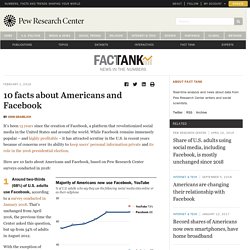
While Facebook remains immensely popular – and highly profitable – it has attracted scrutiny in the U.S. in recent years because of concerns over its ability to keep users’ personal information private and its role in the 2016 presidential election. Podcast enthusiasm is on the rise—find out who’s listening. Pew: Social media overtook print newspapers as a news source in 2018. Americans Still Prefer Watching to Reading the News - and Mostly Still Through Television.
Three-quarters of Americans who prefer watching the news opt for TV, but since 2016, slightly more watchers name the internet as their platform of choice Americans continue to prefer watching the news rather than reading or listening to it, and their viewing loyalties have yet to migrate fully to the web.

Instead, the majority of U.S. adults who prefer to watch the news opt for television as their primary news platform, according to a new Pew Research Center survey conducted July 30-Aug. 12, 2018, among 3,425 U.S. adults who are members of the Center’s nationally representative American Trends Panel. Overall, 47% of Americans prefer watching the news rather than reading or listening to it.
Pew Study Finds Americans Still Prefer Watching to Reading the News – PRsay. A new survey from Pew Research Center revealed that Americans prefer to watch the news rather than read it by a ratio of 47 to 34 percent, marking only a minimal change from 2016’s study, which tallied 46 percent of respondents as news-watchers to 35 percent as news-readers.

Within the subset of news-watching respondents, 75 percent still favor television as their medium of choice. However, the survey suggests this strong majority may not last thanks to the internet. People Spend 479 Minutes A Day Consuming Media 05/30/2018. It’s no secret that the spread of mobile devices and faster mobile data networks has transformed global media consumption in recent years.
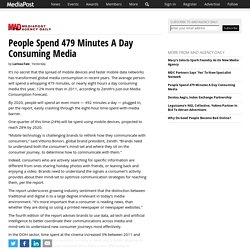
The average person will spend a whopping 479 minutes, or nearly eight hours a day consuming media this year, 12% more than in 2011, according to Zenith's just-out Media Consumption Forecast. By 2020, people will spend an even more — 492 minutes a day — plugged in, per the report, easily crashing through the eight-hour time-spent-with-media barrier. One-quarter of this time (24%) will be spent using mobile devices, projected to reach 28% by 2020. “Mobile technology is challenging brands to rethink how they communicate with consumers,” said Vittorio Bonori, global brand president, Zenith. “Brands need to understand both the consumer’s mind-set and where they sit on the consumer journey, to determine how to communicate with them. " advertisement. Advice for academics when working with journalists (essay) Just because you can read a newspaper, doesn’t mean you can write for one.
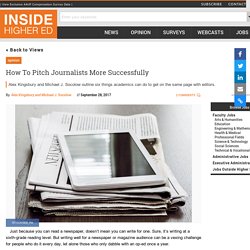
Sure, it’s writing at a sixth-grade reading level. But writing well for a newspaper or magazine audience can be a vexing challenge for people who do it every day, let alone those who only dabble with an op-ed once a year. Yet in the age of fake news and pseudoscience, the need for academics to reach the public is more urgent than ever. 5 media insights for communicators of all stripes. Mainstream media has a public relations problem.
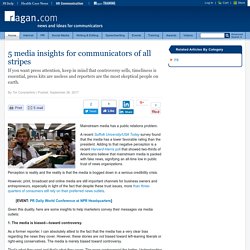
A recent Suffolk University/USA Today survey found that the media has a lower favorable rating than the president. Adding to that negative perception is a recent Harvard-Harris poll that showed two-thirds of Americans believe that mainstream media is packed with fake news, signifying an all-time low in public trust of news organizations. Perception is reality and the reality is that the media is bogged down in a serious credibility crisis. However, print, broadcast and online media are still important channels for business owners and entrepreneurs, especially in light of the fact that despite these trust issues, more than three-quarters of consumers still rely on their preferred news outlets.
[EVENT: PR Daily World Conference at NPR Headquarters] Report: How journalists use social media in 2017. Top Public Relations Today Publicity Data-Driven PR Content for Week of Aug 05 - Aug 11, 2017. Now THAT’S a headline, right?
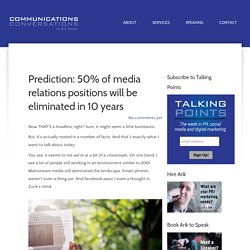
Sure, it might seem a little bombastic. But, it’s actually rooted in a number of facts. And that’s exactly what I want to talk about today. Media trends: Facebook emerges as leading news source - Agility PR Solutions. By Bulldog Reporter on June 27th, 2017 | 0 Comments New research from Ogilvy’s annual global survey of over 250 reporters and editors identifies Facebook as the number one gatekeeper for news, edging out legacy traditional media sources and significantly outpacing other social networks and digital platforms like Google and Twitter.

Carried out by Ogilvy Media Influence team members in 22 offices across North America, EMEA and Asia Pacific, the survey also uncovered that print media is leading the way with successfully adapting in the digital world across all geographies. “Our survey demonstrates that new technology and digital media advancements are changing how we consume news,” said Jennifer Risi, worldwide chief communications officer at Ogilvy, in a news release. “As a news aggregator, Facebook is exposing users to news publications they may not have read otherwise. Additional key findings: This Analysis Shows How Fake Election News Stories Outperformed Real News On Facebook - BuzzFeed News. Civic Engagement Strongly Tied to Local News Habits. In local communities, the civically engaged – the people who vote, volunteer and connect with those around them – play a key role in community life.

Thus, how and to what degree they stay informed about their communities carries added weight. A new study by Pew Research Center in association with the John S. and James L. Knight Foundation reveals that, overall, the civically engaged are indeed more likely than the less engaged to use and value local news. But two particular aspects of civic engagement stand out as most closely associated with local news habits: a strong connection to one’s community and always voting in local elections.
Younger adults more likely than older to prefer reading news. When it comes to technology’s influence on America’s young adults, reading is not dead – at least not the news.
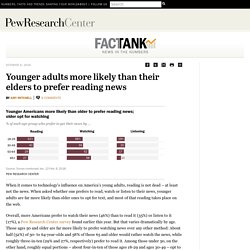
When asked whether one prefers to read, watch or listen to their news, younger adults are far more likely than older ones to opt for text, and most of that reading takes place on the web. Overall, more Americans prefer to watch their news (46%) than to read it (35%) or listen to it (17%), a Pew Research Center survey found earlier this year. But that varies dramatically by age. Those ages 50 and older are far more likely to prefer watching news over any other method: About half (52%) of 50- to 64-year-olds and 58% of those 65 and older would rather watch the news, while roughly three-in-ten (29% and 27%, respectively) prefer to read it.
Employment picture darkens for journalists at digital outlets. It probably comes as no surprise that jobs for journalists at newspapers continue to disappear. But in a disturbing development, digital news jobs that had been replacing some of the legacy positions appear to have hit a plateau. Earlier this year, the Bureau of Labor Statistics released a chart showing the total number of employees working in the newspaper industry is now lower than those working in the “internet publishing and broadcasting” sector.
Given the struggles of the newspaper industry, and the increasing popularity of “digital native” news publishers, such figures may seem intuitive. State of the News Media 2016. Eight years after the Great Recession sent the U.S. newspaper industry into a tailspin, the pressures facing America’s newsrooms have intensified to nothing less than a reorganization of the industry itself, one that impacts the experiences of even those news consumers unaware of the tectonic shifts taking place.
Fact Sheets: In 2015, the newspaper sector had perhaps the worst year since the recession and its immediate aftermath. Average weekday newspaper circulation, print and digital combined, fell another 7% in 2015, the greatest decline since 2010. While digital circulation crept up slightly (2% for weekday), it accounts for only 22% of total circulation. And any digital subscription gains or traffic increases have still not translated into game-changing revenue solutions. The industry supports nearly 33,000 full-time newsroom employees.
Despite current financial strength, though, TV-based news can’t ignore the public’s pull toward digital. News Use Across Social Media Platforms 2016. A majority of U.S. adults – 62% – get news on social media, and 18% do so often, according to a new survey by Pew Research Center, conducted in association with the John S. and James L. Knight Foundation. Books and newspapers will do just fine in 2016. Magazines? Not so much. What makes highly creative people different from the rest of us? In the 1960s, psychologist and creativity researcher Frank X. Barron set about finding out. Barron conducted a series of experiments on some of his generation’s most renowned thinkers in an attempt to isolate the unique spark of creative genius. In a historic study, Barron invited a group of high-profile creators—including writers Truman Capote, William Carlos Williams, and Frank O’Connor, along with leading architects, scientists, entrepreneurs, and mathematicians—to spend several days living in a former frat house on the University of California at Berkeley campus.
The participants spent time getting to know one another, being observed by researchers, and completing evaluations of their lives, work, and personalities, including tests that aimed to look for signs of mental illness and indicators of creative thinking. The creative genius is “occasionally crazier and yet adamantly saner than the average person.” Around half of newspaper readers rely only on print edition. This weekend, Boston Globe editorial employees received an unusual request: Could anyone run a paper route? Due to problems with the paper’s new distributor, some home subscribers had not received their print editions. About 200 Globe workers responded to the call, and hand-delivered copies to local residents.
Although the paper announced Tuesday that it was returning to its old distributor for help with home deliveries, the Globe situation is a reminder that even in the digital era, many local news consumers still rely on the print product for their news. How social media is reshaping news. eBook_NewSchoolPressReleases. Evolution of the PR industry. What about PR has changed since you started your career? From news clips to news links and newspapers to online readers, this graphic highlights the industry's major transformations. By Kristin Piombino | Posted: December 23, 2013. 2013 news consumption trends. News: Personalized or Serendipitous? Every digital news designer faces the question: should the traditional serendipity of contents be preserved or should we go full steam for personalization? It turns out Google is already working on ways to combine both — on its usual grand scale.
Pew surveys of audience habits suggest perilous future for news. 12 trends shaping digital news. The internet and digital devices are changing our news consumption habits. Here are 12 trends to put the rapidly shifting digital news landscape into perspective: 1. More Americans get news online… 50% of the public now cites the internet as a main source for national and international news, still below television, but far above newspapers and radio. Generation on the Go: Creating Branded Content for a Sharing Culture. October 22, 2013 Marketers and PR professionals worldwide are embracing branded content to promote products and services, generate sales leads, establish thought leadership and build brand awareness. Marketers are realizing that print ads, TV commercials and banner ads aren’t enough anymore. Survey: People Aren’t News Reading; They’re ‘News Snacking’ [Infographic] State of News Media 2014.
The news media is even worse than you think. Anyone who feels cynical about the U.S. media has been having a good few weeks. There have been the high profile goofs — by CNN, in its coverage of the Boston bombings, and by Howard Kurtz, the famous media “critic,” in a blog post about gay athlete Jason Collins. The Tribune Company faces a potential takeover by the, er, colorful Koch brothers.
Pew Report: The State of the News Media 2011. Overview. State of the News Media 2012. The Demographics of Mobile News. Americans Regain Some Confidence in Newspapers, TV News. Survey: Trust In Online Ads Grows, While Trust in Print and TV Ads Drops. Reports of the Death of Broadcast News Are Greatly Exaggerated. Next gen of news consumers relies on social media.
An Infographic Look At Generational Media Use. Time Inc. Measures Consumers' Emotional Response to Media. The Tablet Revolution and What it Means for the Future of News.